|
|
High Adventure on the Haute RouteNonfictionNick O’Connell
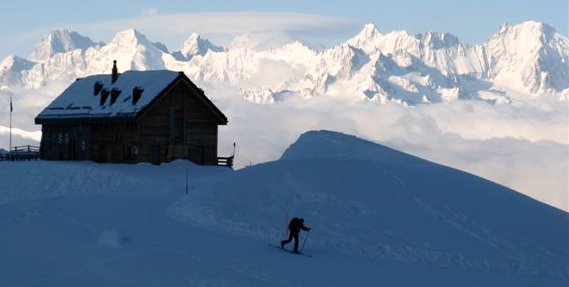
Brad Taylor leaving the Mont Fort Hut with Mont Blanc and the French Alps in the background. All photos this page by Nick O'Connell.
Thrills, Chills, and Danger Topped off by Dinner and a Bottle of Dôle Wine
T he slope ended abruptly at the top of an icy 60-degree couloir. Peering down, I spotted a rock jutting out before the couloir plummeted to the glacier below. I stopped and looked back at our guide. This was the route?
We were descending Rosablanche (10,944 feet), a steep, rocky summit off the Haute Route, the world famous high-altitude ski tour between Chamonix, France and Zermatt, Switzerland. Our Swiss guide, Dominique Fellay, 43, motioned us forward. Until now, everyone had followed. I stopped. “Nick, can I have the rope?” he asked. “What do you have in mind?” Having skied and climbed for many years, I knew the wrong decision could cost us time, energy, and a possible injury. “There’s no problem,” he said, a smile playing across his face. Dominique is tall, broad-shouldered with glacier blue eyes and a dry sense of humor. “I am very happy with the situation.” Happy with the situation? Did I miss something? We were perched above a steep, icy chute. It looked more like an ice climb than a ski run. I had no desire to descend this on telemark skis. But our guide had made the right calls so far, so I handed him the rope. He clipped one end to a piton anchored in the rock and tossed the other end down the couloir. Then he wrapped the rope around his right forearm and demonstrated how to rappel and side-slip the slope. I was dubious, but the rope steadied me as I descended. The six other members of our party followed. After regrouping, we discovered why Dominique had insisted on the rappel. It dropped us into a bowl hidden beneath the shoulder of the peak. It was a mile long and brimming with 30- to 45-degree slopes of pristine powder. While the other groups slogged up and down well-worn skin tracks, we could cut new turns in untracked snow. Dominique took off first, his bright mango parka bobbing down the Mourti Glacier. The rest of us followed, whooping and hollering as we darted back and forth across the slope, crossing and re-crossing each others’ tracks, reveling in the dry snow, the bright sunshine, the huge alpine cirque surrounding us. It was day three of our weeklong attempt on the Haute Route and so far it had proven a ski mountaineer’s dream. The 110-mile (as the crow flies) high-altitude traverse crosses some of the most stunning alpine terrain on the planet, from the massive snow dome of Mont Blanc to the towering rock triangle of the Matterhorn. First completed in 1911, the Haute Route remains the most coveted ski tour in the world. Only half of those who attempt the Haute Route finish it, usually because of the weather. Most of the route lies between 8,000 and 12,000-feet and gets hammered by hellacious storms. It was late March and heavy snows and loaded slopes had forced us to turn back at the Col du Chardonnet, the traditional start of the trip, but once we made our way by car to Verbier on the second day, we reveled in the fresh, light dumps. “You never know about weather in the Alps,” Dominique said. “You have to be flexible.”
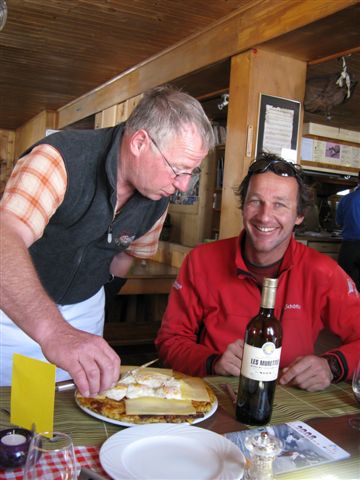
Pierre Antoine, the Dix Hut guardian, serving r�sti to our guide, Dominique Fellay. T he fourth day, the forecast called for föhn winds, which can blow up to 120 miles per hour. We dressed quickly and downed coffee, bread and jam. Our group ranged in age from the mid-30s to early 50s: Bruce Hardardt, Mark Johns, and Fern Hietkamp from Calgary; Brad Taylor from Forest Grove, Oregon; Rob Hampton and me from Seattle. Backcountry ski buddies from way back, we all had tons of experience and weren’t shy about sharing our opinions with Dominique. So far, he’d taken it all in stride.
At the top of the Col des Roux, a French guide inspected my skis and boots. “Telemark?” “Oui.” “Difficile.” He gave me a look that implied I must be crazy. Most people were using alpine touring equipment, but I love the feeling of the telemark turn, even in marginal conditions with a 20-pound pack. We knifed through crusty wind slab and then started a long, descending traverse on boilerplate past Lac Dix, a frozen lake. My knees were screaming by the time we reached the head of the lake. It was like skiing on a tilted hockey rink. At the top of a cliff band, the wind picked up. Putting on my parka and pile hat, I leaned into the wind and kept moving. When it gusted, I stopped. When it died down, I slid forward. The wind whipped across the glacier, stirring up ground blizzards. It felt like I was getting my face sanded off. Rounding the corner near the stone Dix Hut, our destination for the night, the gusts threatened to knock me over. Gripping my poles for balance, I scraped my way forward, teeth clenched, muscles worked, straining to stay upright. The wind burst around me as I opened the heavy wood door of the stone hut. “Bonjour!” A pretty, blond waitress greeted me from the kitchen. I marveled at the contrast between the gale outside and the civilized lunch inside. After dumping my pack, I ordered a plate rösti, a Swiss dish featuring roast potatoes topped with cheese, ham and a fried egg. It was the size of a large pizza and disappeared in minutes. Brad and I ordered another. For the last four days, I’d eaten like a farm animal and my waist continued to shrink. I was becoming a machine that converted calories into vertical feet. Outside the hut, the wind indented the window behind me. I looked out to see figures appear in the distance. They were two British families on holiday in the Alps. The wind gusted, knocking down the kids like bowling pins. They stood up, struggled forward and fell down again. Finally, the guides went outside to help. A teenage boy came in sobbing, his nose dripping with frozen snot. The hut keeper slapped him on the back and helped him off with his boots. Then the rest of the family arrived, exhausted. Later, two skiers staggered in. After shedding packs, they told their story of exploring a line high above Lac Dix. When the wind picked up, they headed down toward the lake. A hundred yards above our tracks, they triggered an avalanche. “It was 5 meters wide and ran 50 meters,” said John, an attorney from Britain. “The snow set like concrete.” The slide buried his friend, Olivier, up to the waist. By the time John reached him, Olivier was in agony, his legs twisted awkwardly. John dug him out. They were running on pure adrenalin as they skied to the hut. Olivier’s left leg was badly wrenched, the ligaments twisted. He had survived, but his trip was over. The hut keeper called for a helicopter; no one was flying in this weather. Olivier’s evacuation would have to wait till tomorrow. To lighten the mood, Rob picked up the hut’s guitar. A guitar teacher and dynamite musician, he soon had the whole place belting out “Country Roads” by John Denver and “Blister in the Sun” by the Violent Femmes. For the finale, he played the Rolling Stone’s “Satisfaction.” Americans, Swiss, Italians, Germans, English, and French harmonized together—it was like a commercial for Coca-Cola. We sang for the fun of singing. We sang for relief at being warm, dry, safe and inside. We sang for the pleasure of being with our buddies in this amazingly beautiful place. “I can’t get no, no satisfaction, no satisfaction, NO SATIS…FACTION!” Rob wind-milled his hand over his head and brought it down hard for the final chord. The place erupted in applause. We’d rocked the Dix Hut!
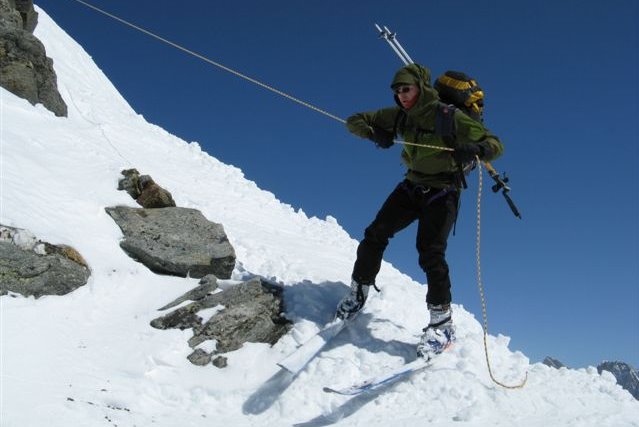
Desperately seeking untracked snow: Rob Hampton rappelling off the ridge on Rosablanche and onto the Mourti Glacier. T he storm raged the next day, obscuring the Pigne d’Arolla (12,375 feet), a massive, glaciated peak. The main route ran past the summit, but it looked impassable.
So Dominique traversed to a lower col, wary of wind slab avalanches. At the base, we lashed our skis to our packs and ascended steel ladders to the top. We stem-christied through heavy wind crust to the snout of the Arolla Glacier and began a long, winding ascent, Dominique out front, Brad behind him as if drafting in a bike race, me behind Brad, the rest of the group following. I breathed deeply, trying to suck oxygen from the thin, bitter air, my breath trailing behind like a ghostly beard. I didn’t see the Vignettes hut until the last minute. It was perched on the edge of a cliff like a barn swallow’s nest stuck to the side of a building. Over a dinner of lamb chops washed down with a bottle of the local Dôle wine, we discussed the next day. Originally, we’d planned to spend two days getting from here to Zermatt, savoring the skiing along the way. “The weather report says sun tomorrow and clouds the next,” Dominique said. “If we want to see the Matterhorn, we should go to Zermatt tomorrow.” This meant 20 miles of travel over three passes with 3600 feet of elevation gain. I was against the idea. I’d been getting tons of exercise, eating great food, drinking good wine and debating with the others about everything from telemark versus AT gear to programs for education reform. “I’m savoring it,” I said. “I don’t want the trip to end.” But Rob and the others wanted to see the Matterhorn. Brad wanted to check for email from his family. Mark thought a quicker trip might help his sore back. Reluctantly, I went along.
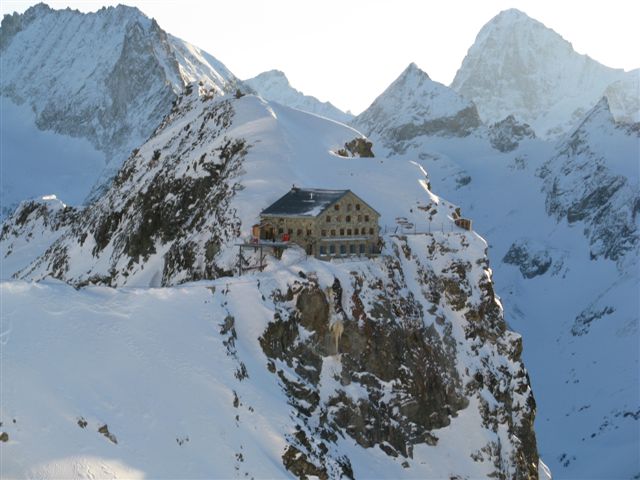
The Vignettes Hut, like a swallow's nest spackled to the side of a wall. S tars glimmered in the western sky as we hiked up the ridge the next morning. The air was clear and cold, the snow-spackled peaks dark and silent in the pre-dawn stillness.
Snapping my boots into the telemark ski bindings, I made a long, descending traverse. Then I crouched into a tuck and shot down the crusty, wind-blown snow, heart pumping, legs straining to avoid a spill, milking as much speed as I could from the slope.
At the bottom, we roped up. We moved slowly through the crystalline world. The snow squeaked as my skis passed over it. Snow crystals gleamed like mica. It was bitterly cold, but eerily beautiful. At the Col de L’Evêque, we soaked up the sun and discussed the route ahead. Mark’s back was bothering him. Fern was having trouble acclimatizing. We weren’t moving fast enough to arrive in Zermatt today. We decided to go back to our original plan. We’d head for the Bertole Hut tonight and Zermatt tomorrow. Now instead of thousands of feet of climbing, we had a three-mile ski run down the Haut Arolla Glacier. It was crusty at the top, but quickly turned into confectioner’s sugar. All I needed to do was think about turning and the skis did the rest. Back and forth. Right and left. I linked turns with the others. I veered off on my own. There was new snow everywhere. You didn’t have to share. I carved turn after turn in slow waltz time, channeling Johann Strauss’s “Blue Danube.” I plunged down a steeper slope and cued up Van Halen. We skied apart, hissing through the silence. We skied together, yelling and hooting and laughing. It was the best run of the trip and we’d almost missed it in our hurry to get to Zermatt. At the bottom of the hill, we high-fived each other. How often do you get such great skiing in such a fantastic setting? Seldom if ever. This was backcountry skiing at its blissed out best. After lunch, we started the long, steep climb to the Bertole Hut at 10,722 feet. Halfway up, I stopped for water. The Alps spread out in all their glory, ridge after ridge, glacier after glacier--more skiing and climbing than I could accomplish in a lifetime.
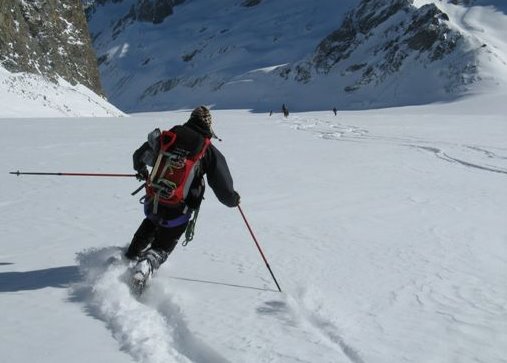
Brad Taylor carving perfect tele turns down the Haut Arolla Glacier. L ight, dry flakes fell the next morning. From the Bertole Hut, we traversed up toward the high col below the Tête Blanche. The snow came harder, stinging my eyes. I couldn’t see more than 100 feet. I burrowed into my jacket and squeezed my hands to keep them from freezing.
At the col, I put on a shell to keep from getting hypothermic. It was a full blizzard now. The new snow made route-finding tricky. Dominique roped up with an English guide to lead us down. The snow was light, fast, forgiving, but I didn’t want to stray from the line they’d taken for fear of falling into a crevasse. Once I glanced back to see I’d just skied past an icefall as large as a two-story building. It was invisible from above. Dominique held his GPS in front of him, picking his way through the obstacle course. He was earning his fee today; I was glad he was doing the route-finding. We dropped down a steep slope, turned left and headed toward the base of the Matterhorn. We poled down the long, flat glacier, picking up speed. We flew past an enormous moraine, tons of glacial debris piled high along the sides. We poled faster, gobbling up the distance, covering ground that would require hours of hiking. We shot past icefalls. Seracs. Hanging glaciers. Shattered rocks as large as houses. It looked like a gigantic troll lurked in the neighborhood, breaking boulders and wreaking havoc on the landscape. The Matterhorn loomed to our right; an immense presence hidden by the clouds. Sticks appeared in the snow—larch trees! Then a house. Two houses. A barn. A road fed onto the ski slopes. Suddenly, we were zooming down a slalom course, surrounded by hundreds of skiers. When we stopped to regroup, an older gentleman noticed our packs. “Where did you come from?” he asked. “Chamonix.” “You did the Haute Route?” We nodded. “Congratulations!” At the bridge into the town, we stopped to take off our skis. I hesitated; they’d grown to feel like extensions of myself. Unlocking them seemed like lopping off part of my legs. Reluctantly, I stepped out of my bindings and shouldered my skis. We walked past big timbered Swiss houses, boutiques selling women’s furs, stores stocked with chocolates, sausages, cheeses and plum eau de vie. People stared as we clumped along in our ski boots, giving off whiffs of bio-hazardous underwear and toxic sock syndrome. At the Walliserkanne Restaurant, we dumped our packs on the outdoor tables. Waiters scurried back and forth bearing trays loaded with pasta, rösti and roast chicken. The maitre de greeted us without a hint of condescension—perhaps he was a skier or maybe he lacked a sense of smell. He put us at a large table in back. We grinned idiotically, unable to conceal our pleasure. Our clothes were filthy, our faces smeared with sweat and sunscreen, but we couldn’t have been happier. We’d done the Haute Route in grand style, with a great guide and fantastic group of friends. We toasted Dominique. It would be hard to find a better guide—safe, strong, knowledgeable, tolerant of our idiosyncrasies. We toasted each other. Despite disagreements over education reform we’d gotten along famously. We toasted the magnificence of the route--rappelling off Rosablanche, singing “Satisfaction” at the Dix Hut, cranking tele turns in untracked powder on the Haut Arolla Glacier, whizzing past the Matterhorn, whose presence we’d felt but hadn’t seen. It was a world unto itself, an incredible mix of high adventure and civilized amenities, surpassing any ski trip I’d ever done. Inside, the food started arriving—plates heaped with rösti, fried trout, grilled venison, chicken with dumplings. Outside, big, fat, wet flakes spiraled down, dusting the hats of pedestrians, piling up on the lamp posts, loading the roofs, covering everything with a thick white blanket. The blizzard had followed us; now it was reclaiming the town.
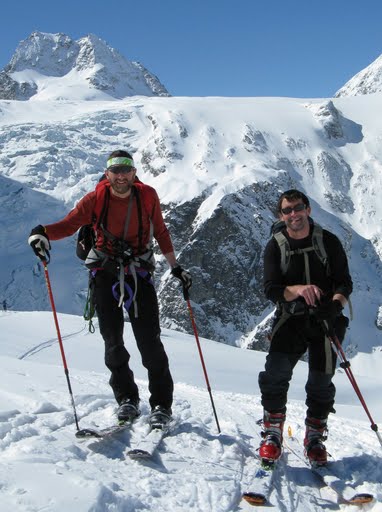
Team Telemark: Brad Taylor and Nick O'Connell on the way up to the Bertole Hut. I f you go: The best time to ski the Haute Route is late March to early April, when there’s lots of snow and daylight, though conditions can be excellent before and after that time, depending on the weather.
GEARING UP FOR THE HAUTE ROUTE GUIDES - ALPINE DREAMS - I highly recommend Dominique Fellay's Alpine Dreams Guide Service for the Haute Route Ski Trip as well as other excursions in the Alps and around the world. Dominique is safe, strong, knowledgeable and a great companion. www.alpine-dreams.com. SKIS – BLACK DIAMOND VOODOO – A stable, versatile, easy-turning ski at a reasonable weight (175 cm at 3.3 kilos), making it an ideal choice for the trip. The skis have enough torsional rigidity to plow through alpine crud and enough width to float over fresh dumps of powder. According to BD, it features a damp 3D CNC-machined wood core with a relaxed Dual Torsion Bow construction for efficient weight with energetic response. It has an upturned tail, keeping skin attachments off the snow for the climb, and a smooth round flex for effortless turns coming down. $519.99. www.bdel.com. BINDINGS – BLACK DIAMOND 01 – A revolutionary design which eases foot fatigue going up and adds edge control going down. A pivot point at the front of the binding acts as a hinge, increasing range of motion when touring. The cables and compression springs offer tight, predictable control for downhill runs. The bindings can be finicky--the springs need regular adjustment, boots must fit exactly into toe box-- but overall a big improvement in performance and worth the price, especially on a trip like this one. $299.95. www.bdel.com. SOFTSHELL JACKET – CLOUDVEIL RAYZAR – The comfort range of this garment is remarkable, from near zero to the 50s. The Schoeller® shell’s combination of breath-ability, water and wind resistance makes this the go to jacket for the trip. The large zippered chest pockets help keep personal gear organized in the crowded huts. $330. www.cloudveil.com. SOFTSHELL PANTS – CLOUDVEIL RAYZAR - The most comfortable and versatile ski pant I’ve ever used. The Schoeller® fabric cuts the wind, while allowing plenty of stretch for skiing and skinning. The optional suspenders, fixed belt loops and a heightened waist keep snow from getting down the back. $300. www.cloudveil.com. HARDSHELL JACKET – ARCTERYX THETA AR - When the blizzard blows in, don this Gore-Tex jacket to block out the wind, cold and snow. It’s exceptionally light given its sturdiness and offers a long, generous cut and seam-sealed, easy-to-use zippers. $450. www.arcteryx.com. HARDSHELL PANTS – ARCTERYX STINGER BIBS – These bomber bibs prove invaluable when the big storms hit, the tough Gore-Tex Pro fabric sealing out the elements. The high back and adjustable suspenders keep the cold at bay, while thigh zippers prevent overheating on the uphill. $449.95. www.arcteryx.com. GLOVES – OUTDOOR RESEARCH ARETES - These versatile gloves adapt to a wide range of conditions, the fleece liners for warmer days, the insulated shells for when temperatures plummet. The articulated fingers allow you to perform tasks like clipping in and out of ski bindings without taking the gloves off, saving your hands from freezing. $79. www.outdoorresearch.com. INSULATED JACKET – MONTBELL ALPINE LIGHT - Going hypothermic? Put on this light, puffy down jacket, the perfect antidote to chilly belays on windy cols. At just over 11 ounces, this highly compressible jacket packs a lot of warmth for little weight or bulkiness. An essential garment for any cold-weather trip like the Haute Route. $150. www.montbell.us. PACK – OSPREY KESTREL 38 - This design hits the sweet spot, offering just enough room (2300 cubic inches) at a reasonable weight (3 pounds, 11 ounces). It combines Osprey’s superior, adjustable suspension system with logical, useful features, including a zippered lower compartment. $139. www.ospreypacks.com. NICHOLAS O'CONNELL, M.F.A, Ph.D., is the author of On Sacred Ground: The Spirit of Place in Pacific Northwest Literature (U.W. Press, 2003), At the Field’s End: Interviews with 22 Pacific Northwest Writers (U.W. Press, 1998), Contemporary Ecofiction (Charles Scribner’s, 1996) and Beyond Risk: Conversations with Climbers (Mountaineers, 1993). He contributes to Newsweek, Gourmet, Saveur, Outside, GO, National Geographic Adventure, Condé Nast Traveler, Food & Wine, The New York Times, The Wall Street Journal, Sierra, The Wine Spectator, Commonweal, Image and many other places.
|
